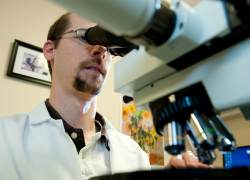
The Department of Pathology and Laboratory Medicine is consistently recognized for its medical student and undergraduate teaching excellence. The department is an active participant in the Vermont Integrated Curriculum (VIC), a series of multidisciplinary courses. Our pathologists are instrumental in the continued success of the curriculum for students.
Well qualified medical students may be interested in the Pathology Medical Student Fellowship offered through the Department of Pathology and Laboratory Medicine.
Pathology & Laboratory Medicine's role in the VIC
Level 1: "Foundations", the pre-clinical portion of the VIC. Pathologists are essential to this level, serving as course director in 1 of the Foundation Courses and as a whole, teaching/facilitating well over 200 hours of the pre-clinical coursework. Pathology residents also play a vital role through engaged learning sessions such as gross organ pathology/clinical correlations and case-based small groups.
Level 2: "Clinical Clerkship", core clinical clerkships required of all medical students. Students rotate through interspersed "Bridge" courses, designed to emphasize clinical applications as the medical students' knowledge base begins to blend "Foundation" knowledge with clinical experience.
Level 3: "Advanced Integration", provides students with additional responsibilities for patient care through clinical electives. Student must also fulfill a requirement for scholarly work in teaching or research.
Pathologists – attendings, house staff officers and student fellows alike – give lectures, teach in laboratories, and facilitate small group colloquia in Cell and Molecular Biology, Human Structure and Function (gross anatomy, microanatomy and physiology), Attacks and Defenses (anemias and general pathology), Nutrition, Metabolism and Gastrointestinal (includes endocrine pathology), Connections (skin, bone and joint), Cardio-Respiratory-Renal, and Generations (includes placental and childhood diseases, genital tracts, breast, hematological diseases, and aging). In addition, the Department offers electives for medical students in the fourth clinical year.